Nitshill Memories
Forty former and current residents were interviewed for the ‘Nitshill Memories’ project, and many more shared their memories and stories via social media and emails. Those communications explored a myriad of topics and, taken together, illuminated what life was like for people living in this former mining village. This next section reveals the history of Nitshill as told by the people who knew it best – the residents.
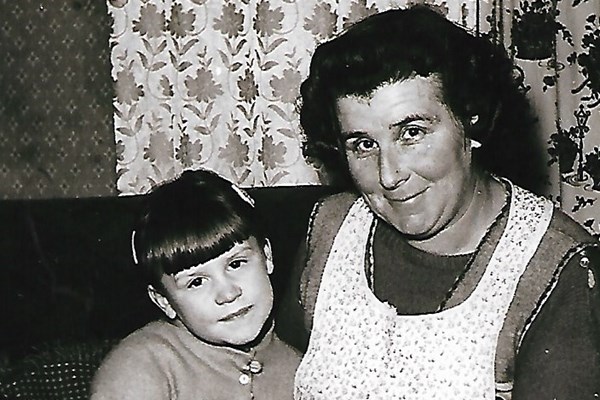
Janet Love with her daughter Betty and the cat ‘Tipsy’, 1959
“Housing”
The flat the family moved to was ‘one up’, on the first floor. They had a veranda facing the communal back court that had washing poles and a bin area – the ‘midden’. The house had three bedrooms, a kitchen, bathroom, and an outside coal bunker. The living room had a coal fire, with a hidden boiler at the back that supplied the hot water. The larger bedroom had a gas fire in a tiled surround. The living room flooring was linoleum, but they had a rug in front of the fire that her Mum had made out of old clothing strips. She had a wooden frame with canvas in the middle, and she weaved the old clothing strips to make a very thick rug. The kitchen had a twin ‘wally’ sink with a wringer in the middle.
I remember the day when my Mammy and Daddy got the keys for the Corporation flat. I was eight years old and, as I mentioned, I was born in Ibrox, and I lived in Ibrox with my Mammy, Daddy, my three sisters and big brother, and we all shared the one bedroom. And that flat was on the top floor of a tenement in Ibrox, and it was rented by my Granny. So, although it was cosy living with my Granny ,in a kind of a way, that move was a big exciting thing, we could stop being so squashed up with no room to swing a cat, so I’d say that was my earliest memory.”
Janette Aitken, East Renfrewshire
Carol lived in the first block (a red sandstone that overlooked the woods) at 56 Pinmore Street, on the first floor. This was a two bedroom flat with a sitting room, kitchen, and bathroom. The heating was from a coal fire in the sitting room (the flat was later fitted with a gas fire). The kitchen had two porcelain sinks, with a mangle inbetween. The coal fire also heated the water in a back boiler. The larger of the two bedrooms had a coal fire in it.
I remember especially, you know, when my Dad would have, kind of, stoked the fire, and I always remember him putting the newspapers up, to get the flame… I used to love when it would go on and I would just sit in the dark….cosy.”
Carol Borland, Glasgow
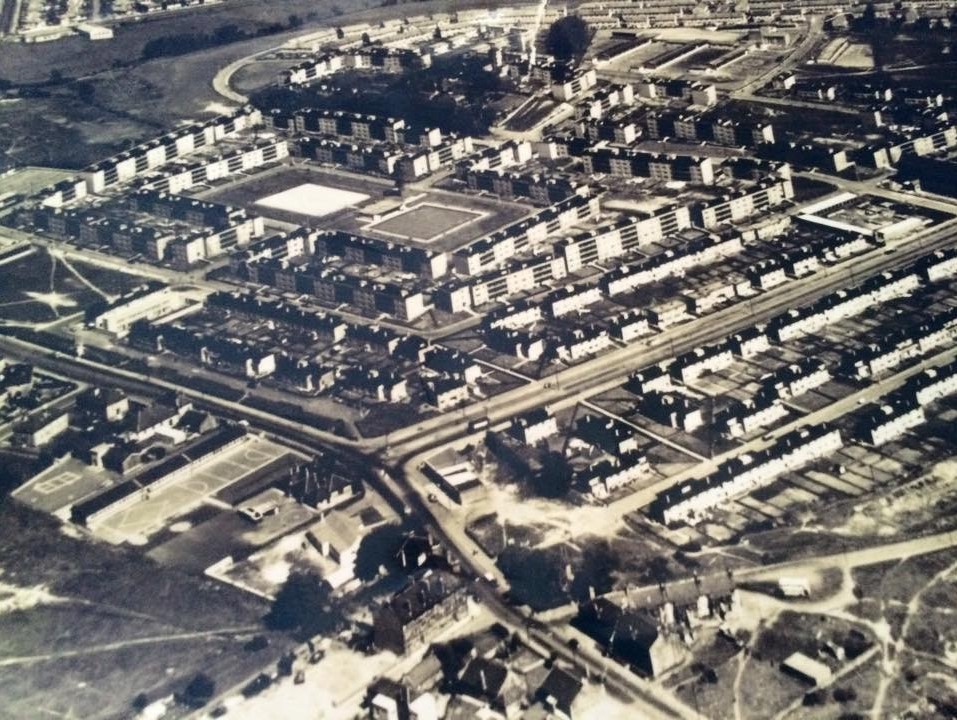
Aerial photo of Nitshill - courtesy of Robert McGuire
Martin’s family lived in a 3-bedroom house, with living room, kitchen, and bathroom. There were six children in the family, but an older brother was in the Army, so he lived away. Martin remembers this big soldier coming home to visit – his brother was 18 years older than him. His parents moved to Nitshill from Port Dundas and were the first people to move into the houses in Househillwood Road. His elder brother had a job in the Co-operative butcher’s shop at Craigbank shops. He was then conscripted into the Army at age 18 and when he came back, he didn’t like being in Nitshill as it was so different from his Army life, so he went back into the Army. Martin’s family lived in a ‘4 in a block’ house. The kitchen had two large sinks with a wringer in between for doing the washing. Next to it, there was a large boiler, which was great for washing his brothers’ working clothes in – they worked in the brickworks. The boiler was also used for making the ‘clootie dumpling’ at Christmas. The coal shed was outside the back door and they took turns bringing in the coal. The whole family has since moved away from Nitshill. His sister moved to Jersey to work, met her husband, and stayed there.
Martin Brady, Cumbernauld
It was a three apartment; it was a corner house. It was two bedrooms, right, but they were bigger bedrooms than the other houses in the street. There were four families in the close.”
Margaret said that their heating came from a back-to-back coal fire. In 1959 the Council upgraded the heating system by fitting a new smokeless fuel fire in the sitting room, a small gas fire was fitted in one of the bedrooms, and a new small electric fire, with tiling around it, was fitted in the second bedroom; a new gas cooker was also fitted. Margaret said that her sister still lives in the house, and the small electric fire with the tiling is still there.
They were cold houses, obviously, really draughty, two beds and a single bed in the girls’ bedroom and the window came in. And it was January, gales blew the window right in, right across the bed and on to the floor. We were all in bed. We had such good neighbours; they all came, and everybody in the street came with their clothes poles to shore the window up from inside the house.”
Margaret Cameron, Barrhead
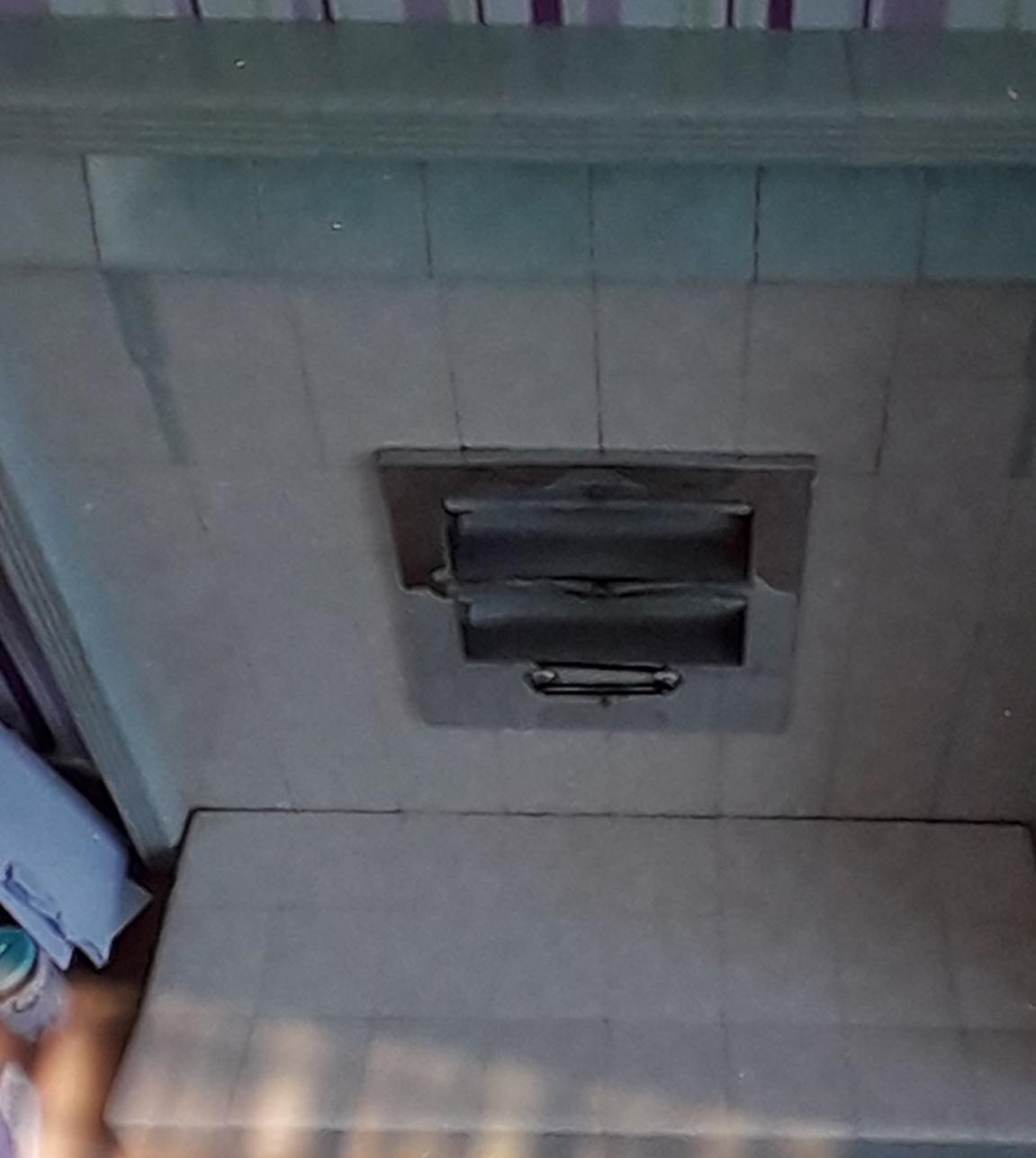
In the 1950s Glasgow Corporation removed all the coal fires and replaced the bedroom fires with these tiled electric fires. This fire is still in the bedroom and is still in use to this day.
We stayed in 8 Dove Street, in a small room and kitchen, and my Uncle Harry stayed with us for a wee while; then we moved to 366 Nitshill Road. We had a range and you cooked at the side of the range. We didn’t have a cooker or anything until a lot of years later. When I left the school at fourteen, I went into the house to look after the house, and I did all the cooking and washing. I used to go into the wash-house with my Auntie Annie Wilson, my mother’s sister, and she taught me how to do the washing and the boiler, and all the rest of it.”
Catherine (Rena) Carlton, Glasgow
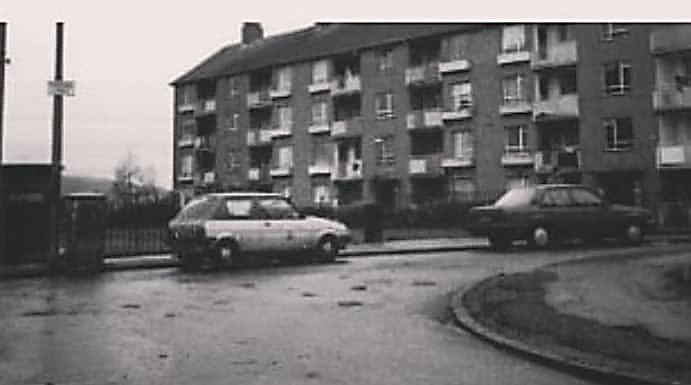
Tenement houses at Pinmore Place, 1970
Coming up to Pinmore was a massive difference, just the fresh air alone, because where we were was almost on the Clyde, and of course they were digging the Clyde Tunnel and the place was alive with rats and mice and what have you, they were jumping all over the place… The house in Nitshill was a kitchen, bathroom, three bedrooms and a veranda… If you go up to Pinmore Street today, they’ve chopped the landing we were on, off, and made it two stories high."
Joe Cassells, Glasgow
It was a four in a block, three bedrooms, big bedrooms with high ceilings, homely, a big garden. It was a Council house that were all the same, most of the houses in the street were the same, and everybody seemed to look out for each other back then. We had an inside toilet with a bath, and a black toilet seat that everybody seemed to have. The toilet was at the end of the hall and had a frosted glass window. We had a gas fire with a back boiler that heated the water as well. The cooker was gas, and the washing machine was a twin tub, and it was the best washing that was ever done. To this day, I stand by a twin tub."
Victoria Corstorphine, East Renfrewshire
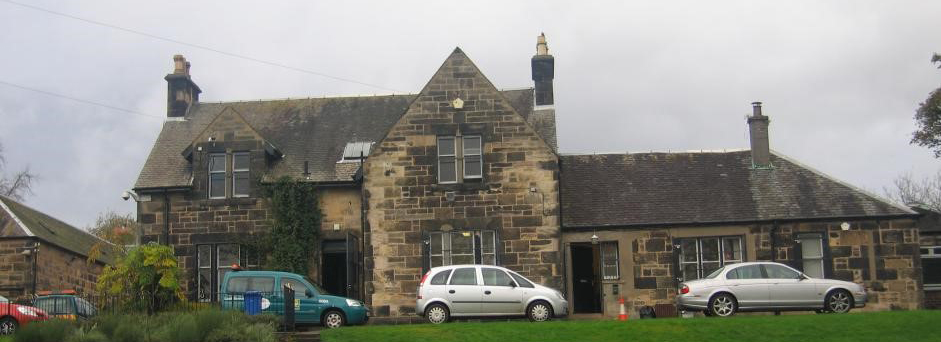
Former Glasgow Corporation Parks Department - opposite ‘Red Hills’ on Barrhead Road
Well, we came from a room and kitchen in the Gallowgate. There was eight of us plus my mother and father, that’s ten, and when we got to the Househillmuir area we thought it was a palace, with three bedrooms we ran about, and a bath and toilet."
Alex said the house had a coal fire in the sitting room, and his mother cooked on a gas cooker in the kitchen. They had a metal boiler, and two sinks with a mangle between them; the boys had to turn the mangle handle to squeeze out the water from the clothes.
There used to be an old boiler to do the washing. You’d put the washing in, and it would boil it up for you, that was until you got a washing machine. You’ve got to remember this was the 1960s/70s and nobody had a machine. There was ten of us in the house and it was a lot of washing for his mother. My mother, actually, she actually won a washing machine in the wee chapel hall."
Alex Dodds, Glasgow
Stayed in a tenement in Nitshill Road, and outside we had the wash-house where all the washing was done with the mangle and all that, and during the summer it had curtains up on it, and that’s where we went for baths. We had an outside toilet. We had a coal fire, and the cellar was outside where the coal was kept, and when you went to the toilet you made a noise to make sure the rats and all that were away. We had an air raid shelter and we used to play in it. We had pots of soup, my mother was good at making pastry and we’d have apple pie and rice pudding."
Marjorie Taylor, Glasgow
The family moved to Nitshill from Drumoyne, as they had been living in a tenement flat and had been offered a larger house with a garden, which suited them better. Lillian’s maternal aunt had already moved to Nitshill with her family and lived nearby. Lillian talked about the kitchen in the house, which was not a fitted kitchen but had a stainless-steel sink. Her mum had a twin tub washing machine, which was an improvement as she had gone to the ‘steamie (wash-house) when they lived in Drumoyne. She remembered her mum using a mangle attached to the sinks, so there must have been two large sinks in the kitchen at first. The family moved from Nitshill to a villa-style house in Mosspark because they needed more room for Lillian’s brother, who had been born with severe disabilities.
Lillian Gaughan, Glasgow
Sandra grew up in a flat on Househillwood Road, Craigbank. The house had three bedrooms, bathroom, kitchen and living room. The kitchen had a gas cooker but was later changed to an electric cooker, and they had a single washing machine with a wringer attached at the top, which was later changed to a twin tub washing machine. Her mother was one of the first people in the area to have an automatic washing machine, called a Hoover Keymatic. The family later moved to a new house in Cleeves Road, Nitshill.
We were lucky because it was centrally heated back in those days, because I was about two when we moved into it. We moved into it when they were built, and you had central heating and hot water all the time, and you had a heated towel rail.”
Sandra Dunbar, Melbourne, Australia
My parents Nan and Joe Ashforth moved to Maybole Street, Nitshill, in 1941 - with three kids Rena (7), Joe (6), myself (1). Leonard, the last child, was the only one born in Nitshill. The house in Nitshill had a coal fire in the living room, a gas wall fire in the smaller bedroom, electric fire on the wall in the other bedroom. Kitchen had a large water tank above the sink. If there was no fire, there was no hot water. However, my electrician father put in an electric water heater. It was used sparingly because it was expensive to heat the water. A gas meter in the kitchen provided gas to stove and oven. In the early days, a penny meter, later converted to a shilling, provided gas for cooker. We also had an electric meter for the electricity. Every quarter the ‘meter man’ came to empty the meters… Bathroom was a bathtub, sink, toilet, with a water tank high above the bowl. My father boxed in the bathtub. No heat, but father installed a lamp on the ceiling that generated heat… We had a stove and a free-standing oven, which I think was cast iron. Wash board and wringer between two sinks. That all changed in 1953, when we got a modern cooker, with oven with top rack to heat the plates! That same year we got a Hoover washing machine, semi-automatic. The kitchen had a pulley for drying clothes."
Marie Hackett (Ashworth), New Jersey, U.S.A.
Catherine’s had a lovely big five apartment house in Nitshill, with four bedrooms, living room, kitchen, and bathroom. The house had three bedrooms and a bathroom upstairs. There was one small bedroom downstairs, a living room and kitchen. There was a big garden at the back, and quite a big garden at the front with a hedge all round it. The water was heated by an immerser and there was a coal fire. There was a gas cooker in the house with four rings, an oven, and the grill on top. Washing for the family was done by Catherine’s mum in a twin tub machine, and there was a mangle attached to the sink for wringing the washing.
Catherine Logue, Glasgow
I was born and brought up in Darvel Street. It was four in a close, and it was a two bedroomed house, one bathroom and a small kitchen. We ate very well, it was simple things like mince and potatoes, stew, all that kind of thing. I can remember, the kitchen was so small and there was a boiler in it and my mother used to put a towel over it, and that’s where I sat because there wasn’t any room."
Ann Martin, Barrhead
We were at the top of a close, it was a three-storey building, we were at the top, it was three bedrooms. When you came in the door, the first bedroom was mine and my two sisters, the next bedroom was my four brothers room, and then the top bedroom was my mum and dad’s, that was the one that was beside the living room and when you came down the other side, it was the kitchen and the bathroom."
They had a gas fire and a gas cooker. Fiona’s mum used a twin-tub washing machine; however, she did have double sinks with a wringer in the middle that she used.
The reason I remember the sinks better, is because that’s where me and my sister, my next sister from me (I’m the youngest), that’s where we were put in for our baths."
Fiona McCrae, Glasgow
We lived upstairs with a house below. It was a four apartment. There was three bedrooms, a living room, a kitchen, and a bathroom, but because there were so many of us and then Brian came along, my Mam was doubling us up, so we had bunk beds. My Mum and Dad had their room. Aye, it was fun times up there. The kitchens were big, a fitted kitchen with a gas cooker. We had central heating. We had a gas fire. Mum had a twin tub washing machine and the back was filled every day, rain or snow."
Theresa McLaughlin, Glasgow
Mary moved to Nitshill from McLean Street, Kinning Park, when she was 6 and a half years old. Her earliest memory of Nitshill, is of having and playing in their garden. The family had lived in a tenement flat and having a garden and an indoor bathroom was wonderful. The family consisted of mother, father, two sisters and two brothers. The house had three bedrooms upstairs and a small bedroom downstairs, which her big sister was given as she was the eldest.
We had a huge big garden and a front garden, which my mum loved, as she just adored putting flowers in and what have you, as she didn’t have that opportunity previously."
There was linoleum on each floor of the house, including the living room, with a linoleum around the outside of a square carpet on the floor. They moved in on a Friday and her mum had to go out the next day to buy material to make curtains, as there were no curtains on the windows. As it was a Council house there was nothing in it when they moved in. The family thought it was amazing, as they had not had stairs in their house before.
Mary McNeil, Glasgow
[We had a] three bedroomed house, four in the block, with back and front garden. My Dad was a great gardener; he grew vegetables in the back garden and rose bushes in the front. It was a lovely house, each room had a coal fire, but we didn’t light each fire. The bathroom had a bath, basin, and toilet. We had a gas cooker, and a boiler to wash clothes and a mangle to wring them out.”
Theresa Mulheron, Jersey, Channel Islands
Their home in the Gorbals was a ‘single end’ with a recess. Liz described her house in Priesthill as “living in luxury”, as it was a four apartment with three bedrooms. Heating was supplied to all the flats from a central system. They had a gas cooker and they did not have a washing machine when they moved in.
It was like a tin boiler in the kitchen, in the corner of the kitchen, and I can remember the smell of the bleach when my Mammy used to do her towels, you know what I mean? And this wee boiler just boiled all the clothes up, and you had a wringer that sat between the two sinks, a Belfast sink on the one side, and the wee sink on the other."
They lived in Shilton Drive for four years and when her mother had a new baby, born with a hole in her heart, the family were rehoused to Househillmuir Road, Nitshill, and that was better because they had a back and front garden.
Elizabeth (Liz) Murray, Glasgow
My Dad worked in the Victoria Pit and there was an accident and he lost part of his leg, and therefore had to give up the mining. He stayed in the wee Miners Row. Between where the new houses are, there was a space with a hill, and my Dad was in the wee miners cottages with his family, his whole family, and they called that hill between the new housing estate at the top and the bottom, they called that Mutrie’s Brae."
Alistair Mutrie, Glasgow
Isabella was born in Govan and moved to Pinmore Street in the Nitshill area when her husband, a docker in Grangemouth, died, and her youngest child was 3 years of age, as her house in the Tradeston area was very small, with an outside toilet, and she had four children over ten years of age. All of her children were born at home. Her house in Pinmore Street was a three-bedroom top floor flat. After living in Pinmore Street for 23 years, she moved to Seamill Street, another three bedroomed flat with a living room, kitchen, and bathroom. The house had coal fires.
Isabella Pert, Glasgow
Susan was born in Lennox Castle Hospital. Her mother said that she was born during the ‘baby boom’ after the war. As so many women were having babies at that time, her mother was sent from Kinning Park in Glasgow, where the family lived, to Lennoxtown, to have her baby. The tenements in Kinning Park were “pretty derelict” and were being pulled down. They lived in a room and kitchen up three flights of stairs, and when they were being demolished, her Mother took the chance of asking for a house in the Nitshill area, and they moved there in 1967, when Susan was aged 12.
It was fantastic, my Mum said it was sheer luxury moving to a house, because we moved from a three stairs up, room and kitchen, with only an inside toilet and no bathroom, to a five apartment semi-detached house with a big back garden. It was fabulous."
The house had a living room, kitchen, and a small bedroom downstairs that was for her, as she was the eldest, and there were three bedrooms and a bathroom upstairs. On having a bathroom, Susan said that when they lived in Kinning Park they had to go to the steamie for a bath once a week, and to now have a bathroom inside the house must have been such a relief to her Mum.
Susan Rasdale, Kilsyth
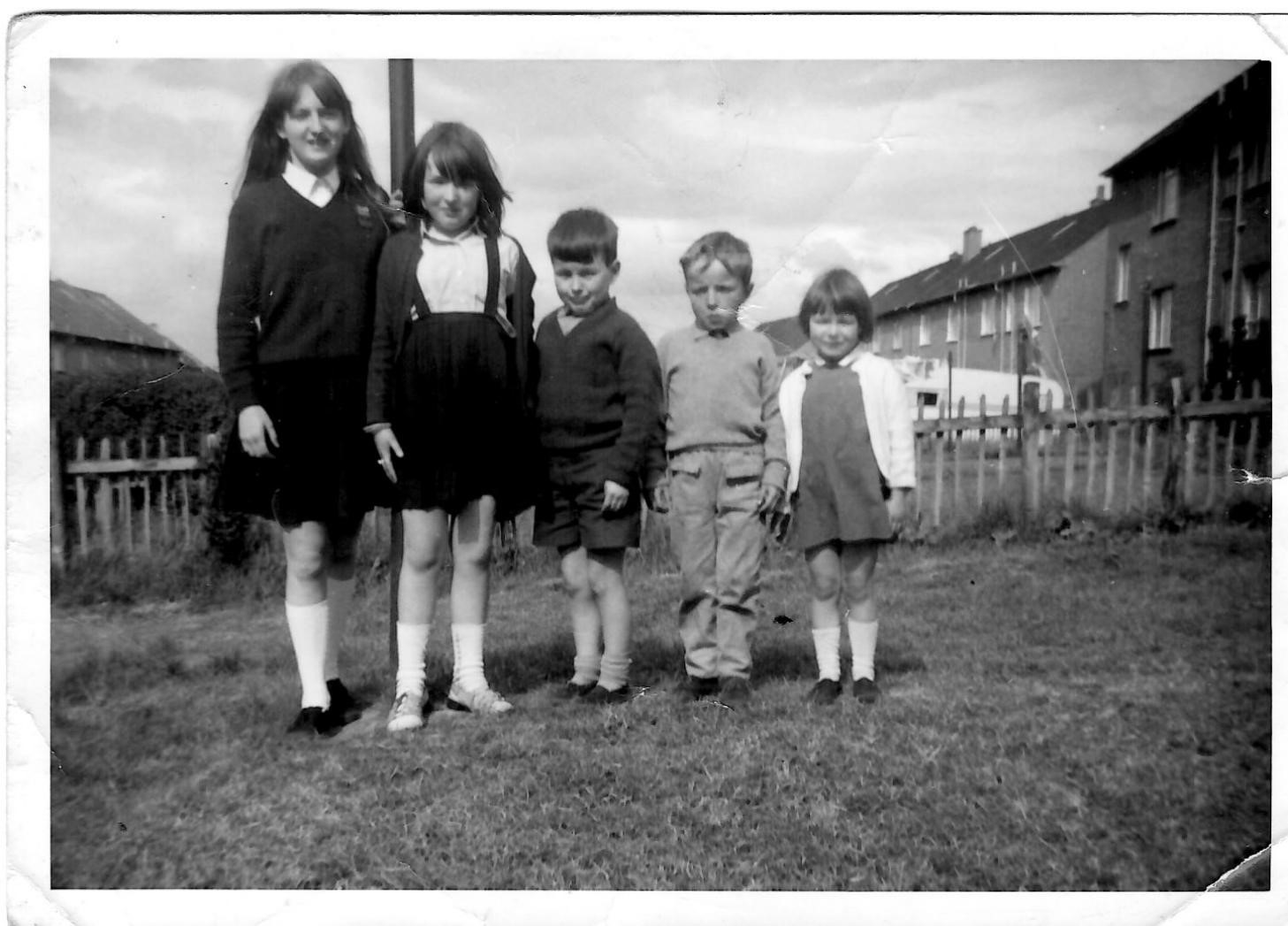
Susan, Mary, George, Neil & Catherine Rasdale in their back garden, Peat Road.
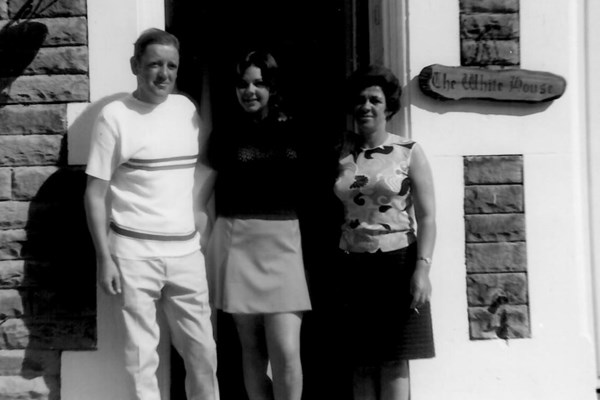
Jimmy, Carol & Mary Osborne, courtesy of Susan Rasdale
We lived in a four-in-a-block, we had the front door, up the stairs, and it had two bedrooms, a living room, bathroom and a kitchen. They didn’t have an awful lot of money, my Mammy and Daddy, but it was always kept clean and tidy. Me, Robert and Anne all slept in the one room, and my Mammy and Daddy had the other room, and when Robert was a bit bigger, obviously he got my Mammy and Daddy’s room, and they slept on a couch settee in the living room until Robert went to live in England, when he was 18, and they went back in to a bedroom."
The house had a coal fire in the sitting room and the rest of the house was freezing. Later, Caroline’s mother bought a paraffin heater for the bedroom and they had to walk to Jackie Conner’s garage on Nitshill Road to buy the paraffin for it. The hot water was supplied by a back boiler in the coal fire. They had a gas cooker in the kitchen and two sinks for washing clothes, with a wringer in the middle of them. When her mother had pleurisy, her sister bought a small single spinner to make washing easier. They later had a ‘Snow Queen’ fridge with a small ice box. Caroline remembers her mother having a supply of coins for the meter, and they looked forward to the electricity man coming to empty the box and seeing how much he would leave for them.
Caroline Reid, Glasgow
We lived in a tenement, or close as they were called in those days, in a three bedroomed flat on the first-floor landing of a four-storey building. It had three bedrooms, a kitchen and bathroom. My mum didn’t have a washing machine in the early days, she used her two ‘wally’ sinks with the wringer in the middle. How she managed all that washing I’ll never know; I certainly couldn’t do that now. We didn’t have a fridge, but we had a pantry cupboard that stored the food. The cooker was gas, and the living room had a coal fire, with a back boiler that heated the hot water."
Elizabeth Walker, Sydney, Australia
Letty remembers that there were two sinks in the kitchen, with a wringer in between to do the washing. Then there was a twin tub, and there was a boiler in a kitchen cupboard for doing the washing too. They also had a veranda, which was ‘the thing’, especially living up a close. Letty and her sister shared a bed for many years, until they were given single beds. This would have been when they were bigger. The flat was heated by a coal fire in the living room, and in her mum and dad’s bedroom. These were eventually replaced by Dimplex heaters. The houses across the road were houses which they called the ‘gas houses’, because they had gas central heating. Letty thought that perhaps those had been built in a different phase, and so had different heating. Washing was dried on a pulley in the kitchen, and there were also clothes poles in the back court, with lines to dry the washing. Letty remembers swinging on them when she was wee.
There were six flats in the close and you had to make sure you were up early to get your washing hung outside, as there was no rota for using the clothes lines. People were up early in those days, so you just had to be organised.”
Letty Smith, Glasgow
Carol’s family moved from a tenement flat in Govan. Their Govan flat was a top flat, ‘single end,’ and had an inside toilet. It was a one roomed flat, which had a fireplace, a recessed bed, a sink at the window, and was also the living room. There was a tiny hall with a toilet. The family’s new house in South Nitshill had a living room, bathroom, two bedrooms and a separate kitchen. This had double Belfast sinks, a boiler in the corner, a cabinet for storing shopping, and a table and chairs. The houses were all electric and had no gas, so the cooker would have been electric. The house had no coal fire and was heated by a 2-bar electric fire in the living room. There was no central heating. They should have had a coal fire in the living room, but it was taken out and an electric fire with surround was put in. The bedrooms were not heated, and there were metal framed windows, which would have been very cold in winter. Carol’s mum did not have a washing machine at first and washing was done in the boiler, then into the sink, and then put through the mangle. Her mum bought a second-hand twin tub washing machine, which took up the whole kitchen. When Carol was 16, her mum went into hospital and Carol told her dad that he should buy an automatic washing machine for her mum. Carol’s boyfriend’s mum had an automatic machine, and this was the first one she’d ever seen. She and her dad went out and bought the washing machine and an upright vacuum cleaner.
Carol Stewart, Glasgow
Susan’s family’s house in Kinning Park had no hot water, just a cold tap in the kitchen, and only a toilet. The family had an inside toilet, which some others did not have, so they were fortunate. The house in Peat Road was a five-apartment consisting of four bedrooms, a living room, kitchen and bathroom, and a big garden. The family was comprised of five children and two adults. The family thought it was wonderful, just having a bathroom and having a bed to themselves, rather than having to share one. “Nowadays you just don’t realise just how cramped up people were living.” Susan said that:
It was quite a difference moving to the house in Nitshill as Peat Road was really very nice, and still is to this day. Quiet and respectable, at least the bit where my family lived. As you got nearer to Nitshill Road, it was not as tidy. People throwing things in the street, cans, and such. We lived in a semi- detached house. The next-door neighbour, Mrs Carmichael, also had around five in her family. It was all big families in these houses. She was very nice, and the other neighbours were all really nice people. When we moved there at first, there was an older couple living next door and they weren’t very friendly when they saw that there were five children!
Susan Stewart, Glasgow
The family moved from a tenement flat in Bridgeton to Nitshill. They had a 3-bedroom house, with a kitchen, living room and bathroom. “That was like Downton Abbey to where we came fae. We’d had two rooms with recesses for the beds.” The new house was heated by a coal fire, which had a back boiler to heat water. There was no separate immersion heater, so they could not have a bath unless the fire had been lit. All of the washing was done by hand in the two sinks in the kitchen. There was a wringer for the clothes, and eventually they got a twin tub machine.
Albert Wallace (Bert), Glasgow
